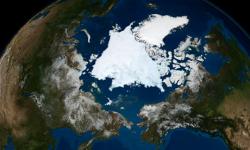
From White House: While the Arctic region has experienced warming and cooling cycles over millennia, the current warming trend is unlike anything previously recorded. The reduction in sea ice has been dramatic, abrupt, and unrelenting. The dense, multi-yearice is giving way to thin layers of seasonal ice, making more of the region navigable year-round. Scientific estimates of technically recoverable conventional oil and gas resources north of the Arctic Circle total approximately 13 percent of the world’s undiscovered oil and 30 percent of the world’s undiscovered gas deposits, as well as vast quantities of mineral resources, including rare earth elements, iron ore, and nickel. These estimates have inspired fresh ideas for commercial initiatives and infrastructure development in the region. As portions of the Arctic Ocean become more navigable, there is increasing interest in the viability of the Northern Sea Route and other potential routes, including the Northwest Passage, as well as in development of Arctic resources. . . .
United States Security Interests
Our highest priority is to protect the American people, our sovereign territory and rights, natural resources, and interests of the United States. To this end, the United States will identify, develop, and maintain the capacity and capabilities necessary to promote safety, security, and stability in the region through a combination of independent action, bilateral initiatives, and multilateral cooperation. We acknowledge that the protection of our national security interests in the Arctic region must be undertaken with attention to environmental, cultural, and international considerations outlined throughout this strategy. As many nations across the world aspire to expand their role in the Arctic, we encourage Arctic and non-Arctic states to work collaboratively through appropriate fora to address the emerging challenges and opportunities in the Arctic region, while we remain vigilant to protect the security interests ofthe United States and our allies.
To accomplish this line of effort, the United States Government will seek to:
•Evolve Arctic Infrastructure and Strategic Capabilities – Working cooperatively with the State of Alaska, local, and tribal authorities, as well as public and private sector partners, we will develop, maintain, and exercise the capacity to execute Federal responsibilities in our Arctic waters, airspace, and coastal regions, including the capacity to respond to natural or man-made disasters. We will carefully tailor this regional infrastructure, as well as our response capacity, to the evolving human and commercial activity in the Arctic region.
• Enhance Arctic Domain Awareness – We seek to improve our awareness of activities, conditions, and trends in the Arctic region that may affect our safety, security, environmental, or commercial interests. The United States will endeavor to appropriately enhance sea, air, and space capabilities as Arctic conditions change, and to promote maritime-related information sharing with international, public, and private sector partners, to support implementation of activities such as the search-and-rescue agreement signed by Arctic states.
•Preserve Arctic Region Freedom of the Seas – The United States has a national interest in preserving all of the rights, freedoms, and uses of the sea and airspace recognized under international law. We will enable prosperity and safe transit by developing and maintaining sea, under -sea, and air assets and necessary infrastructure. In addition, the United States will support the enhancement of national defense, law enforcement, navigation safety, marine environment response, and search-and-rescue capabilities. Existing international law provides a comprehensive set of rules governing the rights, freedoms, and uses of the world’s oceans and airspace, including the Arctic.
The law recognizes these rights, freedoms, and uses for commercial and military vessels and aircraft. Within this framework, we shall further develop Arctic waterways management regimes, including traffic separation schemes, vessel tracking, and ship routing, in collaboration with partners . We will also encourage other nations to adhere to internationally accepted principles. This cooperation will facilitate strategic partnerships that promote innovative, low-cost solutions that enhance the Arctic marine transportation system and the safe, secure, efficient and free flow of trade.
•Provide for Future United States Energy Security – The Arctic region’s energy resources factor into a core component of our national security strategy: energy security. The region holds sizable proved and potential oil and natural gas resources that will likely continue to provide valuable supplies to meet U.S. energy needs.
Continuing to responsibly develop Arctic oil and gas resources aligns with the United States“all of the above” approach to developing new domestic energy sources including renewables, expanding oil and gas production, and increasing efficiency and conservation efforts to reduce our reliance on imported oil and strengthen our nation’s energy security.
Within the context of this broader energy security strategy, including our economic, environmental and climate policy objectives, we are committed to working with stakeholders, industry, and other Arctic states to explore the energy resource base, develop and implement best practices, and share experiences to enable the environmentally responsible production of oil and natural gas as well as renewable energy. . . .
Strengthen International Cooperation . . .
As appropriate, we will work with other Arctic nations to develop new coordination mechanisms to keep the Arctic region prosperous, environmentallys ustainable, operationally safe, secure, and free of conflict, and will protect U.S., allied, and regional security and economic interests.
Excerpts from "National Strategy for the Arctic Region." (photo: Reuters)
Image: reuters%205%2015%2013%20Satellite-image-of-Arctic.warsawbiopic.jpg
